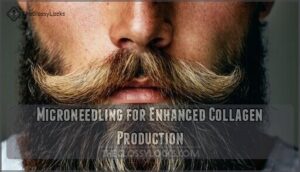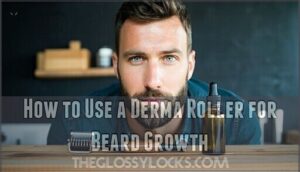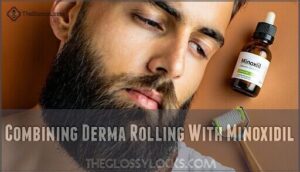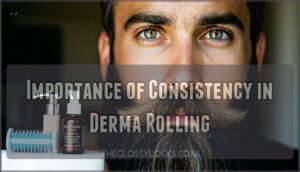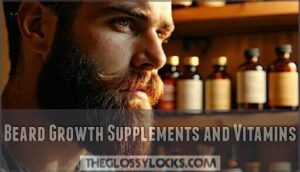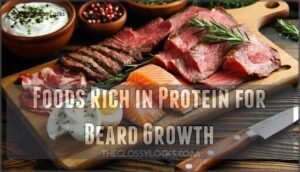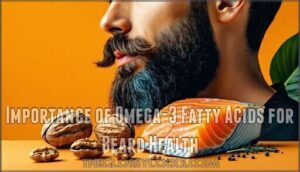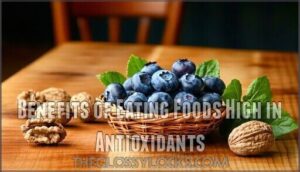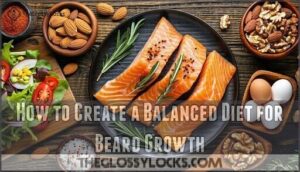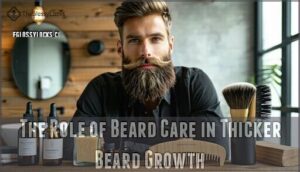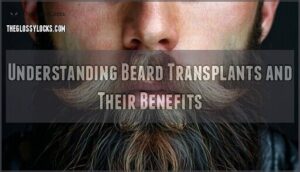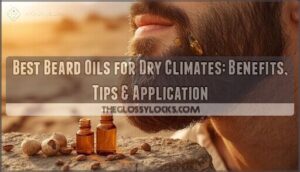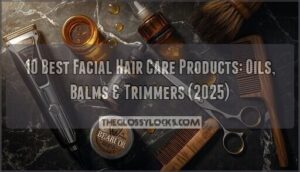This site is supported by our readers. We may earn a commission, at no cost to you, if you purchase through links.

Boost testosterone naturally through strength training, proper sleep, and stress management while eating DHT-supporting foods like olive oil and coffee.
Use derma rolling every 3-4 days to increase blood flow and collagen production by 400%, potentially improving density by 18%.
Take biotin for keratin production, vitamin D for follicle health, and zinc for DHT conversion.
Maintain consistent beard care with oils and balms while eating protein-rich foods and omega-3s.
Most guys miss the synergy between these methods—understanding how they work together reveals serious growth potential.
Table Of Contents
- Key Takeaways
- Enhance Beard Growth Naturally
- Effective Beard Growth Techniques
- Beard Growth Supplements and Vitamins
- Optimizing Beard Growth With Diet
- The Role of Beard Care in Thicker Beard Growth
- Understanding Beard Transplants and Their Benefits
- Frequently Asked Questions (FAQs)
- How to grow a beard faster?
- How to grow a thicker beard?
- Do men really want a thicker beard?
- How long does it take to get a thick beard?
- How to grow a fuller beard?
- Will a thin beard thicken?
- What is the best way to grow beard faster?
- Is there a way to stimulate your body to grow beard fast?
- Why is my beard growing slowly?
- How long do I have to wait to achieve full beard growth?
- Conclusion
Key Takeaways
- Optimize your hormones naturally – You’ll boost testosterone and DHT through strength training, quality sleep, stress management, and eating foods like olive oil and coffee to fuel faster beard growth.
- Use derma rolling for circulation – You can increase blood flow and collagen production by 400% with weekly 0.5-0.75mm derma rolling sessions, potentially improving beard density by 18%.
- Target nutrition with key supplements – You’ll accelerate growth by taking biotin for keratin production, zinc for DHT conversion, and vitamin D for follicle health while eating protein-rich foods.
- Combine methods for maximum results – You’ll see the best results when you synergize hormone optimization, mechanical stimulation, targeted nutrition, and consistent beard care rather than relying on just one approach.
Enhance Beard Growth Naturally
Your beard’s growth potential depends heavily on testosterone and DHT working together with your follicles’ androgen receptors.
You can naturally optimize these hormone levels through targeted nutrition, lifestyle changes, and proven techniques that activate dormant hair follicles, which can help improve your beard’s growth by utilizing androgen receptors.
Importance of Testosterone and DHT
When you’re starting your beard growth journey, testosterone and DHT are your secret weapons for beard growth acceleration.
These beard growth hormones work together—testosterone converts into DHT, which directly stimulates follicle health and creates thicker beard naturally.
Your beard genetics determine how sensitive your follicles are to these hormones, but optimizing hormone balance can reveal your beard’s potential.
Understanding the role of hormone levels is essential for effective beard growth strategies.
Here’s what proper testosterone boost and DHT levels deliver:
- Transforms weak, patchy areas into robust hair coverage
- Accelerates growth from sluggish to visibly thicker within months
- Strengthens individual hair strands for a fuller appearance
- Awakens dormant follicles you didn’t know existed
- Creates the masculine presence that commands respect
Role of Androgen Receptors in Facial Hair
Understanding how your facial hair responds to hormones starts with androgen receptors.
These specialized proteins in your hair follicles must bind with testosterone and DHT from your bloodstream to trigger beard growth.
Your receptor binding efficiency determines how well this process works.
Four key factors affect your androgen sensitivity:
- AR gene variations – inherited differences in receptor structure
- Follicle receptor density – how many binding sites you have
- DHT binding affinity – how tightly hormones attach to receptors
- Hormone balance – ideal testosterone and DHT levels in circulation
Poor receptor binding means even high DHT levels won’t maximize your facial hair growth potential.
Balancing Hormone Levels for Thicker Beard
Your hormones hold the keys to beard growth success.
Testosterone boost and DHT balance work together to activate dormant follicles.
Hormone therapy can address low androgen levels, while natural methods like strength training and proper sleep optimize beard growth hormones.
Stress management prevents hormonal disruption.
When hormone balance improves, follicle stimulation increases, creating the perfect environment for beard growth stimulation and thicker facial hair.
How to Increase Testosterone Naturally
Building on balanced hormone levels, you can naturally boost testosterone through targeted lifestyle changes.
Resistance training and HIIT workouts increase testosterone production while reducing body fat. Quality sleep and stress management prevent cortisol from suppressing hormone levels.
Additionally, adopting healthy habits like weight loss strategies can have a significant impact on hormone balance.
- Diet Optimization: Focus on healthy fats, protein, and complex carbs while avoiding excessive alcohol
- Natural Supplements: Consider fenugreek or ashwagandha for hormone balance support
- Stress Reduction: Practice relaxation techniques to maintain ideal testosterone levels
Foods That Boost DHT Levels
Now that you’ve kickstarted testosterone production, specific DHT rich foods can supercharge your hormone diet for natural beard growth.
Testosterone foods like alfalfa sprouts boost DHT by 21%, while olive oil increases testosterone by 17%.
Coffee and raisins pack DHT boosters that fuel thicker beard development.
These food supplements work as powerful beard growth tips for maximum results.
Effective Beard Growth Techniques
Beyond genetics, you can actively enhance your beard’s thickness using proven techniques that boost circulation and stimulate dormant follicles.
These methods work by delivering more nutrients to your facial hair roots and creating ideal conditions for growth.
Derma Rolling for Increased Circulation
Your personal circulation booster that awakens sleeping follicles and delivers beard-building nutrients exactly where you need them
Derma rolling works like a personal trainer for your beard follicles. This technique creates tiny micro-injuries that trigger your body’s healing response, boosting blood flow to dormant hair follicles.
Studies show over 60% of users see noticeable improvements in beard density after 12 weeks of consistent use. The increased circulation delivers nutrients and growth factors directly to your hair follicles, potentially improving beard density by 18% when combined with proper nutrition.
Here’s your derma rolling game plan:
- Choose needles between 0.5-0.75mm for ideal skin stimulation
- Roll once weekly to avoid excessive inflammation
- Sterilize with alcohol for 10 minutes before each session
- Apply gentle pressure in multiple directions across beard areas
For best results, understanding derma roller benefits is essential to maximize the effects of derma rolling on beard growth, and to see noticeable improvements in beard density, it is crucial to follow the game plan and maintain consistent use.
Microneedling for Enhanced Collagen Production
Your skin’s repair system kicks into high gear with microneedling’s Collagen Stimulation power.
This Facial Rejuvenation technique creates controlled micro-injuries that trigger Skin Regeneration and enhanced Beard Enhancement.
Studies show microneedling boosts collagen production by 400%, giving you a thicker beard through improved follicle health.
| Microneedling Benefits | Timeline |
|---|---|
| Collagen boost starts | 24-48 hours |
| Visible beard improvement | 4-6 weeks |
| Peak facial hair results | 3-4 months |
How to Use a Derma Roller for Beard Growth
When you’re ready to release your beard’s potential, grab your derma roller and follow these Derma Roller Tips for maximum Beard Stimulation. This Hair Thickening technique creates Follicle Activation through controlled Skin Exfoliation.
Your derma roller sessions will enhance beard growth through proven beard growth stimulation methods. Understanding the proper derma roller products is vital for effective beard growth techniques.
Here’s your beard growth techniques roadmap:
- Roll vertically, horizontally, and diagonally across beard area
- Use 0.5-0.75mm needles for ideal penetration depth
- Apply gentle pressure – let the tool do the work
- Clean your derma roller with rubbing alcohol before and after
- Limit sessions to 2-3 times weekly for best results
Combining Derma Rolling With Minoxidil
Maximize your beard growth potential by pairing derma roller sessions with minoxidil application.
Wait 24 hours after rolling before applying minoxidil to avoid irritation.
This follicle activation combo enhances absorption and accelerates beard growth stimulation.
Skin preparation through microneedling creates pathways for better penetration of beard growth products, delivering thicker beard results faster.
Importance of Consistency in Derma Rolling
Your consistency’s the secret weapon for derma rolling success.
Stick to a regular schedule—typically every 3-4 days—to maintain steady skin stimulation and follicle activation.
Skipping sessions disrupts the growth cycle, while overdoing it causes irritation.
Think of it like training muscles: you need consistent effort, not sporadic bursts.
Proper technique with your derma roller creates the perfect environment for hair thickening.
Remember, patience pays off when building your beard care routine to grow thicker beard naturally.
Beard Growth Supplements and Vitamins
While genetics determine your beard’s baseline potential, targeted supplements can help you maximize what you’re working with.
The right vitamins and minerals address nutritional gaps that might be limiting your follicles from reaching their full growth capacity.
Benefits of Biotin for Beard Growth
Think of biotin as your beard’s personal trainer, strengthening each hair from the inside out.
This powerhouse vitamin supports keratin production, which forms the foundation of strong, thick hair follicles.
Biotin supplements can enhance nutrient uptake and improve growth patterns when you’re deficient.
Research shows biotin deficiency affects hair quality, but most people get enough through diet.
If you’re considering beard growth supplements, biotin works best alongside other beard growth vitamins for a thicker fuller beard.
Here’s what biotin brings to your grooming game:
- Stronger strands that resist breakage and splitting
- Enhanced thickness as follicles produce healthier hair
- Better growth consistency across patchy areas
Remember, patience pays off – you’ll typically see improvements after three months of consistent use.
Role of Vitamin D in Facial Hair Growth
Beyond biotin, vitamin D plays a key role in beard thickness.
This vitamin supports hair follicles by promoting cellular growth and differentiation, creating ideal conditions for facial hair development.
Low vitamin D levels can weaken growth factors that enhance beard growth.
Get sunlight exposure or consider beard growth vitamins containing vitamin D to maximize these natural methods for beard growth enhancement.
How to Choose The Right Beard Growth Supplements
Navigating the supplement maze requires smart choices backed by solid research. Only 15% of beard growth supplements reference clinical trials, making your selection process critical for achieving results.
Key Selection Criteria:
- Third-party testing certifications – Look for NSF or USP verification to guarantee supplement safety and purity
- Transparent ingredient lists – Avoid proprietary blends that hide effective dosing information
- Biotin concentrations between 2,500-10,000 mcg for ideal beard vitamins effectiveness
- Customer reviews with photo evidence – Focus on products with 100+ verified reviews showing actual results
- Clear dosage guidelines – Natural enhancers should specify exact amounts to prevent adverse reactions
Choose growth boosters containing biotin, zinc, and B-vitamins while avoiding excessive fillers. Herbal remedies like saw palmetto show promise, but remember that beard growth products work best when combined with proper nutrition and consistent use. Understanding the role of beard growth supplements is essential for making informed decisions about your beard care routine.
Importance of Zinc and Magnesium for Beard Health
Zinc and magnesium are mineral powerhouses for your beard growth journey.
Zinc deficiency can sabotage DHT conversion, while magnesium benefits include optimizing mineral absorption and supplement timing.
You’ll need zinc-rich foods like oysters and pumpkin seeds, plus magnesium from spinach and almonds.
These minerals work together, fueling thicker beard growth through enhanced nutrition and hormonal support for healthier follicles.
Potential Risks of Taking Beard Growth Supplements
Several beard growth supplements can backfire if you’re not careful about supplement side effects and overdose risks.
While promising a thicker beard, these beard growth products may trigger hormone imbalance, liver damage, or allergic reactions instead.
Consider these potential beard growth risks:
- Biotin overdose – Excessive intake can interfere with lab test results and cause skin breakouts
- Zinc toxicity – Too much zinc blocks copper absorption, leading to immune system problems
- Hormone disruption – Some supplements alter testosterone levels unpredictably, causing mood swings
- Liver stress – High-dose vitamins can overwhelm your liver’s processing capacity over time
- Drug interactions – Beard growth supplements may interfere with prescription medications you’re already taking
Optimizing Beard Growth With Diet
Your diet directly impacts beard thickness by supplying the building blocks your follicles need to produce strong, healthy hair.
Certain foods can boost testosterone and DHT levels while providing essential nutrients that transform patchy growth into a fuller beard, which is crucial for achieving a thicker beard.
Foods Rich in Protein for Beard Growth
Your beard thrives on protein sources like lean meats, fish, and eggs—the building blocks of keratin.
Fish benefits include omega-rich salmon, while egg nutrition delivers complete amino acids.
Meat options such as chicken and beef fuel growth, and dairy alternatives like Greek yogurt work too.
A protein-rich diet directly supports thicker beard development through proper beard nutrition to grow a thicker beard effectively.
Importance of Omega-3 Fatty Acids for Beard Health
Beyond just eating right, omega-3s reveal your beard’s true potential through powerful inflammation control and enhanced nutrient delivery.
Fatty Acid Benefits transform your beard health by supporting the beard growth cycle from within:
- Fish Oil Supplements deliver concentrated omega-3s directly to follicles
- Healthy Fats from salmon and walnuts strengthen hair structure
- Omega 3 Effects reduce scalp irritation that stunts growth
- Beard Nutrition improves when omega-3s boost blood circulation
These omega3s create the foundation for a thicker beard.
How to Incorporate Vitamin C Into Your Diet
While omega-3s build the foundation, vitamin C acts as your beard’s personal bodyguard against damage.
You’ll supercharge your thicker beard growth by loading up on these vitamin C powerhouses that boost collagen production and improve your beard care routine.
- Citrus fruits like oranges deliver 70mg of vitamin C per serving—nearly your full daily intake requirement
- Red bell peppers pack 190mg per cup, making them immune boosters that outshine most citrus fruits
- Broccoli and leafy greens provide vitamin D absorption benefits while supporting your nutrition goals
Benefits of Eating Foods High in Antioxidants
Your body’s natural defenses get a powerful boost when you consume Antioxidant Rich Foods daily.
These nutritional powerhouses combat Free Radical Reduction and minimize Oxidative Stress, creating ideal conditions for Cell Regeneration and enhanced Nutrient Absorption.
Blueberries, walnuts, and dark leafy greens protect your follicles from cellular damage while supporting beard growth.
This targeted nutrition approach strengthens your beard care routine, helping you achieve that coveted thicker beard through strategic antioxidants consumption.
How to Create a Balanced Diet for Beard Growth
Creating a smart meal planning strategy fuels thicker beard growth by combining protein intake from lean meats with healthy fats from nuts and fish.
Your nutrient balance should include zinc-rich foods and biotin sources for ideal beard nutrition.
This beard growth diet approach, supplemented with targeted dietary supplements, transforms your protein-rich diet into a beard growth supplements powerhouse for maximum results.
The Role of Beard Care in Thicker Beard Growth
Proper beard care forms the foundation of thicker, healthier facial hair growth by creating ideal conditions for your follicles to thrive.
You’ll maximize your beard’s potential through strategic moisturizing, styling, and maintenance techniques that support natural growth patterns.
Importance of Using Beard Oil for Moisturizing
Proper beard moisture transforms rough whiskers into manageable facial hair that actually grows thicker.
Quality beard growth oil delivers essential nutrients directly to your follicles while promoting skin health underneath.
Here’s how beard oil supercharges your growth:
- Follicle Care – Natural oils penetrate deep, nourishing hair roots for stronger growth
- Beard Softening – Eliminates scratchy texture that makes beards appear thinner
- Oil Benefits – Jojoba and argan oils mimic your skin’s natural sebum production
- Skin Health – Prevents flaky "beardruff" that clogs follicles and stunts growth
- Thicker Beard – Well-moisturized hair appears fuller and more voluminous than dry, brittle strands
Using a beard growth product is essential for maintaining healthy beard growth.
Benefits of Using Beard Balm for Hold and Style
While beard oil handles moisturizing, beard balm delivers superior hold and styling control for your thicker beard.
This styling product contains natural waxes that tame flyaways while adding volume.
Key beard styling benefits include:
- Enhanced hold techniques – Keeps unruly hairs in place all day
- Improved beard texture – Creates fuller, more structured appearance
- Dual-action care – Balm ingredients moisturize while providing styling power
How to Trim Your Beard for a Thicker Appearance
Strategic trimming creates the illusion of facial hair density when done correctly. Focus on beard shaping that emphasizes your strongest growth areas while minimizing patchy spots.
Use quality beard trimming tools with adjustable guards for precision. Trimming tips include working with dry hair and cutting less than you think you need.
| Trimming Area | Technique | Visual Impact |
|---|---|---|
| Cheek Line | Keep it natural, avoid over-trimming | Maintains fullness |
| Neckline | Define 2 fingers above Adam’s apple | Creates structure |
| Length | Trim uneven hairs, not overall length | Enhances uniformity |
This approach to beard styling maximizes your natural thicker beard potential without sacrificing precious growth. Understanding proper beard trimming techniques is essential for achieving a thicker and healthier beard.
Importance of Regular Beard Maintenance
Your beard won’t thrive on autopilot. Beard maintenance creates the foundation for thicker beard growth through consistent beard hygiene and follicle stimulation.
Regular washing removes buildup that clogs pores, while beard conditioning softens hair texture and prevents breakage. Skin exfoliation twice weekly unclogs follicles and boosts circulation.
Daily beard care with quality oils nourishes both skin and hair, maximizing your beard growth potential. Skip the routine, and you’re sabotaging months of progress.
Grooming isn’t vanity—it’s strategy.
Understanding Beard Transplants and Their Benefits
When natural methods fall short of your beard goals, transplant procedures offer a surgical solution to permanently fill patchy areas and create fuller coverage.
This medical approach moves individual hair follicles from donor areas like your scalp to targeted spots on your face, providing immediate density where genetics failed to deliver, utilizing a technique that can be considered a form of transplant.
How Beard Transplants Work
When naturally patchy facial hair leaves you frustrated, beard surgery offers a permanent solution through advanced hair restoration techniques.
During facial hair transplantation, surgeons harvest healthy hair follicles from your scalp’s donor area and strategically implant them into sparse beard regions using precise grafting techniques.
Modern transplant procedures create:
- Natural-looking density that matches your existing facial hair pattern
- Permanent results that grow like regular beard hair
- Customizable coverage targeting specific areas needing enhancement
- Minimal scarring with advanced FUE method extraction
This hair restoration procedure typically costs several thousand dollars but delivers lasting transformation for men seeking fuller beards.
Types of Beard Transplants (FUE and FUT)
Two main facial hair transplantation techniques dominate hair restoration: FUE Procedure extracts individual hair follicles with minimal scarring, while FUT Method removes tissue strips but yields more grafts per session.
| Aspect | FUE Procedure | FUT Method |
|---|---|---|
| Scarring | Minimal pinpoint marks | Linear scar across donor area |
| Transplant Costs | Higher per graft | Lower per session |
| Surgical Risks | Reduced complications | Longer healing time |
| Recovery | 5-7 days | 10-14 days |
Choose based on your scarring tolerance and budget.
Pre-Transplant Preparation and Post-Transplant Care
While preparation sets the foundation for transplant success, thorough postoperative care determines your final results.
Follow these critical steps:
- Donor Site protection: Keep the harvested area clean and avoid touching to prevent infection
- Transplant Recovery requires 7-14 days of gentle washing and avoiding strenuous activities
- Graft Survival depends on following your surgeon’s Postoperative Care instructions precisely for maximum Hair Follicle integration and thicker beard development
Understanding the beard growth phases is vital for maximizing transplant success and overall beard health.
Potential Risks and Side Effects of Beard Transplants
Before diving into beard transplant territory, you’ll want to understand the potential downsides. Transplant Risks can derail your facial hair restoration dreams if you’re unprepared.
Surgical Complications affect roughly 2-5% of patients, while Graft Failure occurs when transplanted hair follicles don’t take root properly.
| Risk Type | Occurrence Rate | Recovery Time | Cost Impact | Long-term Effects |
|---|---|---|---|---|
| Scarring Issues | 3-7% | 2-6 months | Revision surgeries | Permanent marks |
| Infection Rates | 1-3% | 1-2 weeks | Antibiotics needed | Possible graft loss |
| Graft Failure | 5-15% | 3-6 months | Touch-up procedures | Patchy results |
| Swelling/Bruising | 80-90% | 7-14 days | Minimal | Temporary |
| Numbness | 10-20% | 1-3 months | None | Usually resolves |
Choose experienced surgeons to minimize these beard growth risks and protect your investment.
Frequently Asked Questions (FAQs)
How to grow a beard faster?
Achieve lightning-fast beard growth by applying minoxidil 3% daily, derma rolling weekly with 5mm needles, consuming alfalfa sprouts and olive oil, taking biotin supplements, exercising regularly, and getting quality sleep nightly.
How to grow a thicker beard?
Boost thickness by using minoxidil daily, derma rolling weekly, taking biotin supplements, eating protein-rich foods, and managing stress. Exercise regularly and get adequate sleep to optimize testosterone levels naturally.
Do men really want a thicker beard?
Like Samson’s legendary mane, you’re drawn to facial hair’s masculine mystique. Research shows 73% of men desire fuller beards, viewing thickness as a symbol of virility and maturity that commands respect.
How long does it take to get a thick beard?
You’ll see noticeable thickness in 2-4 months with proper care, though genetics determine your maximum potential. Full density typically develops over 6-12 months of consistent growth and maintenance.
How to grow a fuller beard?
Growing a fuller beard flows like a steady river gaining strength downstream.
Use minoxidil 5% daily, derma roll weekly with 5mm needles, and fuel growth with protein-rich foods containing biotin and zinc for maximum results.
Will a thin beard thicken?
Your beard thickness can improve with time and proper care.
Genetics sets your baseline, but minoxidil, derma rolling, testosterone optimization through diet and exercise, and beard oils can enhance what you’ve got.
What is the best way to grow beard faster?
Picture your face as fertile ground awaiting transformation.
Apply minoxidil 5% twice daily—it’s clinically proven to boost growth rate and density.
Combine with derma rolling using 5mm needles weekly to enhance circulation and nutrient delivery to dormant follicles, promoting density.
Is there a way to stimulate your body to grow beard fast?
You can stimulate faster beard growth through minoxidil application, derma rolling, testosterone-boosting foods like olive oil and coffee, plus proper nutrition with biotin and zinc supplements.
Why is my beard growing slowly?
Your follicles might be hitting genetic limits, struggling with poor circulation, or lacking key nutrients like protein and biotin.
Low testosterone, stress, or simply impatience could be slowing things down too.
How long do I have to wait to achieve full beard growth?
Rome wasn’t built in a day, and neither’s your beard. You’ll typically see full growth potential after 2-4 months of consistent care, though genetics determine your maximum density and length.
Conclusion
Like Rome wasn’t built in a day, your beard won’t transform overnight—but these six proven methods create the foundation for remarkable results.
When you combine hormone optimization through strength training and proper nutrition with derma rolling’s circulation boost, you’re targeting beard growth from multiple angles.
Add targeted supplements like biotin and zinc, maintain consistent care routines, and you’ll discover how to grow a thicker beard faster than relying on genetics alone.
- https://thebeardclub.com/blogs/beard-culture/discover-beard-genetics
- https://nashvillehairdoctor.com/fue/hairline/debunking-common-beard-and-hair-growth-myths/
- https://www.reddit.com/r/beards/comments/1km30nr/does_beard_have_a_limit_size_based_on_genetics/
- https://wimpoleclinic.com/blog/expert-tips-on-how-to-grow-a-fuller-healthier-beard/
- https://wolfandiron.com/blogs/feedthewolf/10-diet-changes-you-need-to-make-for-beard-growth


